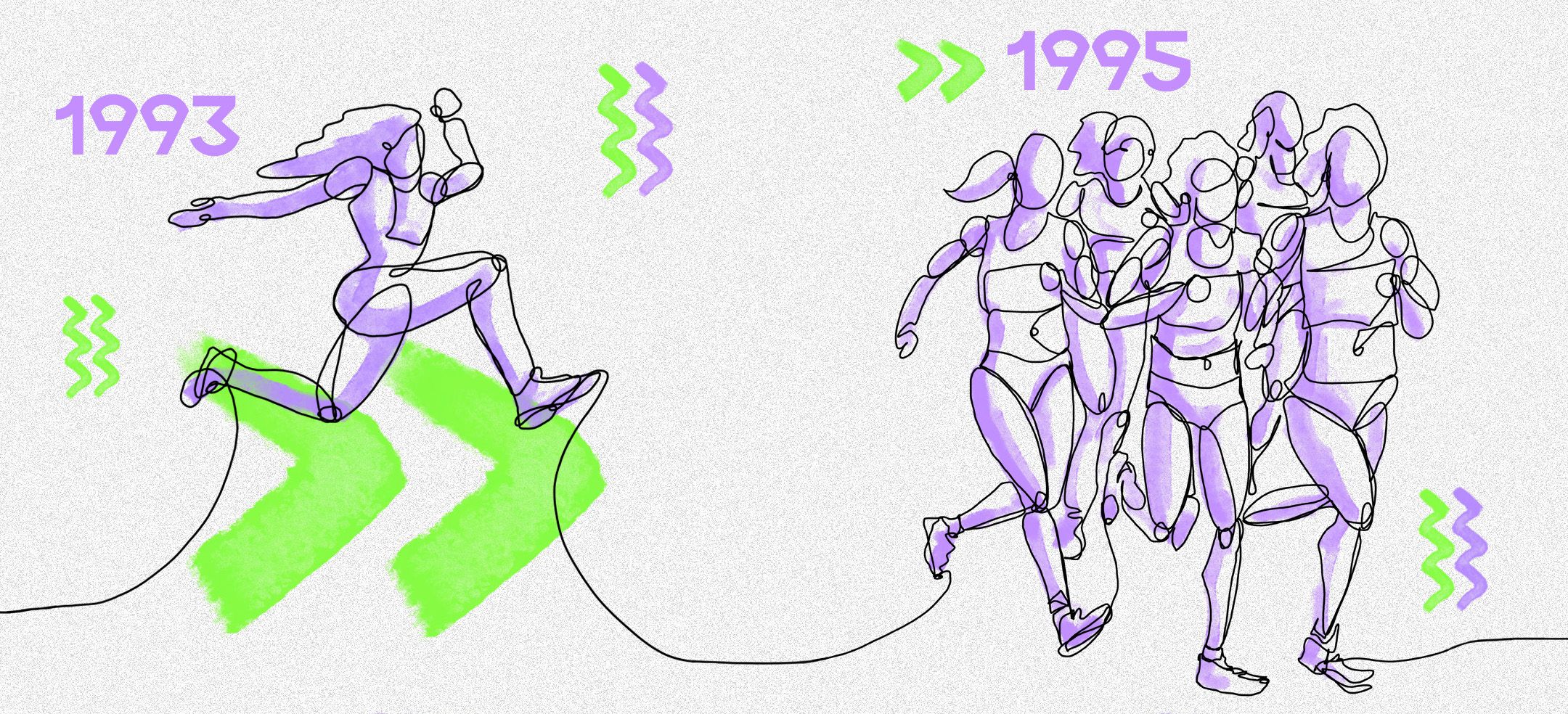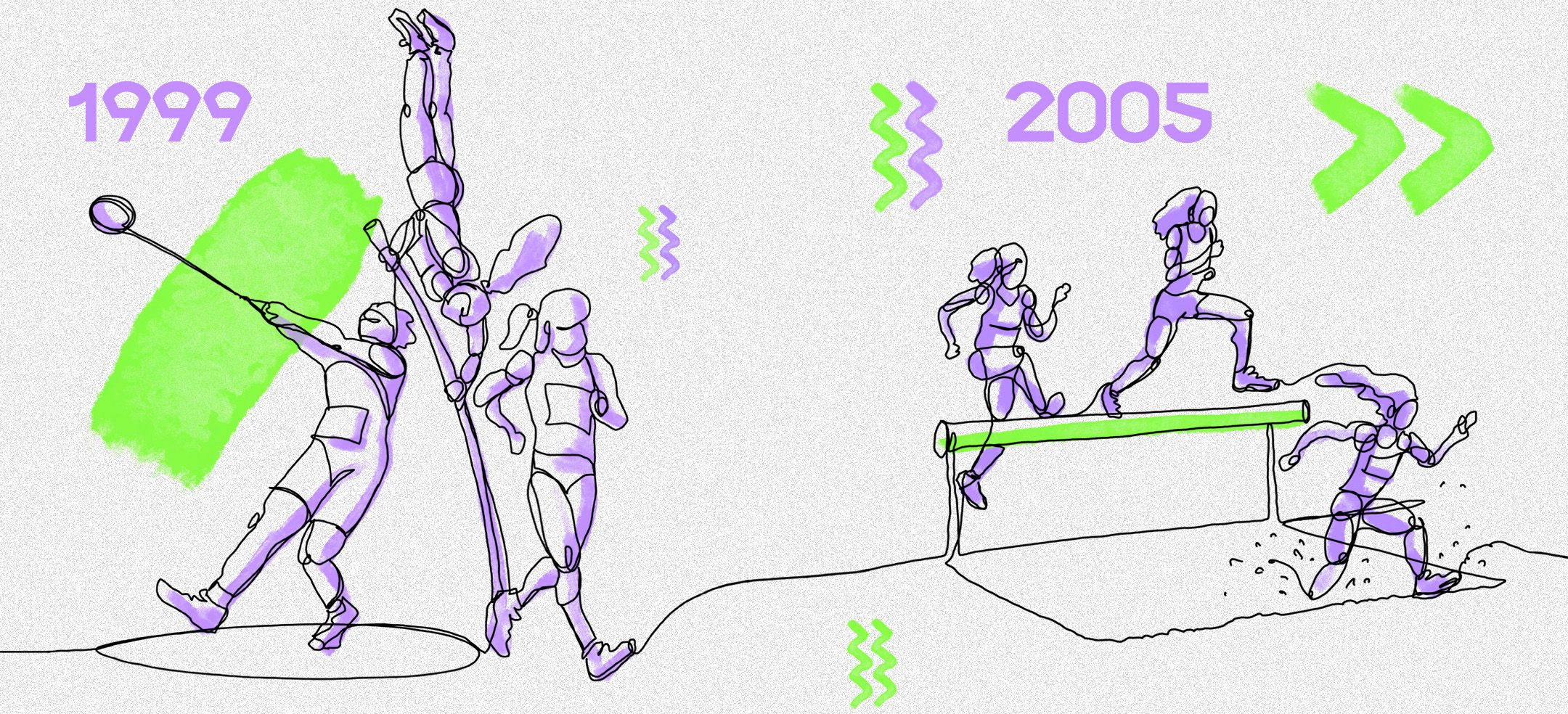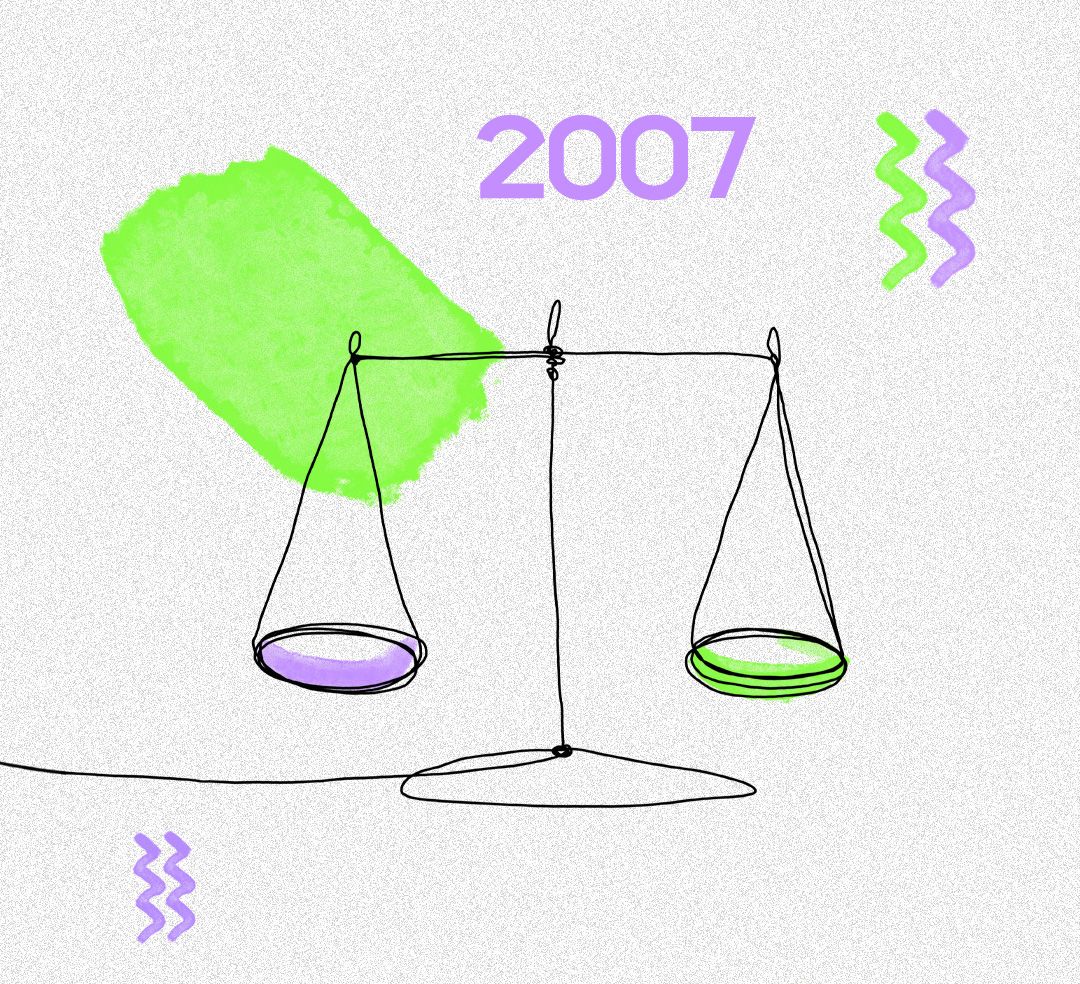Evolution of World Athletics Championships (© Christel Saneh)
Think of the World Athletics Championships over four decades without conjuring memories of Allyson Felix’s record 14 gold medals, Yulimar Rojas’ hattrick of triple jump titles, Jackie Joyner-Kersee’s astonishing heptathlon and long jump double, or Tirunesh Dibaba’s historic 5000m-10,000m double.
The World Championships would be a poor imitation of what it has become without the remarkable performances of these and many other female athletes. For the celebration of 40 years of the World Athletics Championships this year is also a celebration of the march towards gender equality for women in athletics.
From Grete Waitz winning the inaugural women’s world marathon title in Helsinki in 1983 to Sydney McLaughlin-Levrone smashing the world 400m hurdles record in Oregon in 2022, the expansion of opportunity for female athletes has been one of the most striking features in the evolution of the event.
However, the long road towards equality began almost a century before and was paved by the female pioneers of the 20th century, whose defiance and determination created the foundation for today’s stars to soar.
Unlike the first World Championships, the first modern Olympics in 1896 – and those of the next 30 years – offered no women’s events. It was only at the ninth edition of the Games in 1928 that five women’s events were introduced, which grew to nine in 1948 and 17 at the inaugural World Athletics Championships. There was finally parity with the number of men’s events – 24 – at the 2017 World Championships.
It was in 1921 – 25 years after the first modern Olympics – that the first international athletics competition for women was staged. Held on a clay pigeon shooting ground in the gardens of the Monte Carlo Casino in Monaco, the ‘Women’s Olympiad’ was created by Alice Milliat – a driving force in women's sport. Milliat, whose own sporting specialism was rowing, was a founding member of the Fédération des Sociétés Féminines Sportives de France in 1917 and in 1921 she created the International Women's Sports Federation (FSFI).
Milliat’s campaign for women’s events to be included in the Olympic Games finally saw results in 1928, but as the great late statistician and writer Mel Watman explained in his 2012 book The Official History of the WAAA 1922-2012: “The struggle to get women’s track and field events into the Olympics was prolonged and bitter.” Only five disciplines were added to the programme: the 100m, 800m, 4x100m, high jump and discus. Among the performances was a world record by Germany’s Lina Radke in the women’s 800m, but exaggerated reports of apparent competitor post-race distress caused the discipline to be removed. Until 1960, the longest women's Olympic running event was the 200m and the cap in international competition remained 1500m until the 1980s.
Timeline towards World Athletics Championships parity
August 1983 – inaugural World Athletics Championships held in Helsinki, Finland. The programme features 17 women’s events, compared to 24 men’s events

September 1987 – the women’s 10,000m and 10km race walk are added to the programme for Rome
August 1993 – athletes compete in Stuttgart for the first women’s world triple jump title

August 1995 – the women’s 5000m replaces the women’s 3000m in Gothenburg
August 1999 – the women’s pole vault makes its World Athletics Championships debut in Seville after first featuring at the 1997 World Indoor Championships. The hammer is also added to the programme, while the 20km race walk replaces the 10km race walk

August 2005 – the World Athletics Championships returns to Helsinki and this time the women’s 3000m steeplechase is contested
August 2017 – parity in the number of track and field events is achieved at major global championships as the women’s 50km race walk is added to the World Athletics Championships programme in London

At that point, USA’s Jacqueline Hansen was among those pushing for change.
Running a 2:38:19 marathon in 1975 in Oregon – where Gotytom Gebreslase would win the women’s world title in a championship record of 2:18:11 47 years later – Hansen became the first woman to break 2:40 for the 26.2-mile event, guided by another women’s running pioneer: Doris Brown Heritage.
“I had more than a year and a half to savour my world record,” Hansen later recalled, quoted in a World Athletics feature announcing the donation of the shoes she wore for that 2:38 run to the Museum of World Athletics (MOWA).
“During that time, I took the opportunity to lobby in various ways for the ‘cause’ of a women’s marathon in the Olympics. I spoke to anyone who would listen.
“The exclusion of women distance runners in the Olympic Games had been a never-ending source of frustration to me since 1972. I wanted other women runners to realise that my achievement was not so spectacular; that we all should be running in the 2:30s; that women would – should – be running in the 2:20s in five years.
“Only four years later, enter Grete Waitz. I was attending a sports good show in Los Angeles when word came to me of her tremendous 2:27 in the New York City Marathon. My skin prickled with goose bumps, as it had in Eugene four years before.”
Waitz would go on to win the inaugural women’s world marathon title in Helsinki in 2:28:09.
Another champion for change was Kathrine Switzer, best known as the first woman to run the Boston Marathon as an official entrant in 1967, but also the organiser of the Avon International Women’s Marathon in London in 1980. That event helped to showcase the talent and international representation in the discipline, for it to be considered for the Olympic programme.
“Ever since I crossed the finish line of the Boston Marathon in 1967, I wanted to do two things,” she said in a 2018 interview with Athletics Weekly. “One, become a better athlete, but more than that, I wanted to create opportunities for women.”
Speaking with Amby Burfoot for his 2016 book First Ladies of Running, Switzer added: “I think the Olympic marathon was in many ways as important as giving women the vote. Everyone had come to accept what women could do in the social and intellectual realms, but it took the Olympic marathon to show the world how physical and powerful women could be.”
The women’s marathon made its Olympic debut in 1984, when the 3000m and 400m hurdles were also added to the programme to mirror the events that had been staged at the inaugural World Athletics Championships the year before.
Women on the world stage
Since the beginning of the professional sport era in the 1980s, athletics had parity in pay, and when World Athletics Championships prize money was introduced, it was immediately equal for women and men. But there was work to do before there was parity in play.
The first edition of the World Athletics Championships featured 17 women’s events, compared to 24 for men. Among the inaugural women’s champions was USA’s Mary Decker, who achieved a 1500m and 3000m double.
Over the next decade the pressure built for the IAAF to offer more opportunities for its female athletes. One of the main roles of the global governing body’s Technical Committee was, with the advice of statisticians, to decide on which events, women’s and men’s, should be added or removed from the official world records list and major championships programmes. They would take their recommendations to the association's ruling Council, who would make the final decision. This procedure determined whether an event discipline had reached a sufficient international standard and depth to be considered. However, how can something be expected to evolve if it isn’t being showcased? Instead, athletes let their performances do the talking. In the situation of the fast-developing female athletics scene, the impressive progression in some events was too hard to ignore.
In 1987 the women’s 10,000m and 10km race walk were added to the World Championships programme, Norwegian great Ingrid Kristiansen claiming that first 10,000m title in Rome in 31:05.85.
World Athletics Championships participation
| Edition | Teams | Women | Men |
| Helsinki 1983 | 153 | 458 (34.3%) | 877 (65.7%) |
| Rome 1987 | 157 | 548 (38.7%) | 868 (61.3%) |
| Tokyo 1991 | 164 | 626 (40.4%) | 925 (59.6%) |
| Stuttgart 1993 | 187 | 667 (39.5%) | 1022 (60.5%) |
| Gothenburg 1995 | 191 | 677 (37.5%) | 1127 (62.5%) |
| Athens 1997 | 198 | 709 (37.7%) | 1173 (62.3%) |
| Seville 1999 | 201 | 763 (41.2%) | 1091 (58.8%) |
| Edmonton 2001 | 189 | 699 (46.7%) | 798 (53.3%) |
| Paris 2003 | 198 | 744 (44.3%) | 935 (55.7%) |
| Helsinki 2005 | 191 | 762 (45.1%) | 926 (54.9%) |
| Osaka 2007 | 197 | 850 (47.1%) | 953 (52.9%) |
| Berlin 2009 | 200 | 857 (45.2%) | 1038 (54.8%) |
| Daegu 2011 | 199 | 811 (46.6%) | 931 (53.4%) |
| Moscow 2013 | 203 | 784 (43.9%) | 1000 (56.1%) |
| Beijing 2015 | 205 | 814 (46.2%) | 947 (53.8%) |
| London 2017 | 199 | 875 (47.1%) | 982 (52.9%) |
| Doha 2019 | 206 | 826 (46.5%) | 949 (53.5%) |
| Oregon 2022 | 180 | 809 (47.4%) | 896 (52.6%) |
After the triple jump joined the programme in 1993, the 5000m replaced the 3000m in 1995 before the pole vault, hammer throw and 20km race walk were added in 1999, the latter replacing the 10km race walk.
USA’s Stacy Dragila became the inaugural women’s world pole vault champion in Seville in 1999, clearing 4.60m to equal the world record. Two years prior, on this day (9 March) in 1997, she won the first women’s world indoor pole vault title in a clash against some of the trailblazers who had helped to take the event to such a high level.
“Emma George from Australia was someone I aspired to be like,” said Dragila in a 2021 interview with Kate Carter in which she reflected on that global indoor contest. “I was able to compete against her for two years prior; I remember watching her in awe and wishing that I could compete at her level.”
But, as she added: “When I was young, I didn’t have a lot of role models who were visible and that I could be inspired by.”
That’s a sentiment echoed by one of the sport’s current stars.
“I started pole vault when I was 12 years old. I saw the high schoolers doing it and knew I needed to try it, it looked so fun,” explained USA’s reigning Olympic and world champion Katie Moon, who was aged nine when the women’s pole vault made its Olympic debut in Sydney in 2000.
“I begged the coaches for a couple of days to let me go over (to try the event) because at that point, women’s pole vault wasn’t really a thing. It had just started in the year 2000 in the Olympics. I didn’t know anything about the professional circuit until I was much older.”
It was also Dragila who won the inaugural Olympic women’s pole vault title in 2000 – more than a century after the first men’s event had taken place.
By that point the world record was 4.63m. Remarkable progression for an event that was only added to the world record list in 1994, when the best mark was 4.05m.
It was George who really helped the event to soar and outdoors she took the level from 4.25m in November 1995 to 4.60m in February 1999.
And there was depth, too. In 1995, five women cleared 4.10m or higher. In 1996, the figure was 14. By 2000, the event had reached the point where 10 women were soaring over 4.50m or above.
Similar moves were being made in other events and in 2005 the women’s 3000m steeplechase made its World Athletics Championships debut, Dorcus Inzikuru winning Uganda’s first ever world gold medal. The competition was back in Helsinki, at a championships featuring 23 disciplines for women – six more than at the debut edition in the same city two decades prior.
Twelve years later, the addition of the women’s 50km race walk to the World Championships programme meant that women could finally compete in the same number of disciplines as men at major global championships.
The work of a century was done. Thanks to the aforementioned trailblazers and many other pioneers, we now have 391 women’s world gold medal-winning moments over 40 years, and another 24 to come in just a few months’ time in Budapest.
Jess Whittington for World Athletics





